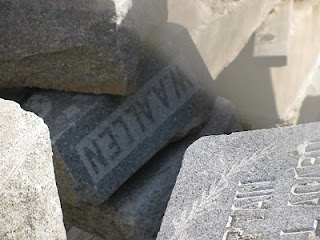One of the frustrating aspects of genealogy can be finding the burial place for an ancestor. Sometimes it can feel like you have checked out every cemetery in an area and still not find where that ancestor was buried.
The more I know about cemeteries the more I am convinced that it is a miracle when we do find a burial. Too often there are a host of reasons why an ancestor's burial place cannot or may not ever be found. A good example is the use of wooden crosses or headstones to mark a burial. These deteriorate over time making them unreadable. In some cases even granite headstones can become difficult to read.
The place where a person is buried can lead to why you cannot find their burial. In the case of one of my ancestors, he is buried on the family farm that has not been owned by family since the early 1900's. The land is now used for grazing cattle and the home and cemetery are no longer visible. In another example, a family cemetery is now under the 9th hole at a golf course with no monument left to remember those buried there.
The examples could go on and on. In at least 2 instances in Southern California there are cemeteries that, because they were in disrepair, were turned into parks. Families was notified and those that wanted to move their loved ones to another cemetery were given that chance and those that weren't removed are now buried under a city park.
(Photos courtesy of Audry McDonald (c) 2010 )
One example of this comes from Whittier, California where two adjacent cemeteries, Mount Olive and Broadway are now the Founders Memorial Park. What did they do with the tombstones? Well they piled them in the back of the Whittier Museum where they now sit. While there is a memorial marker at the park with names, one descendant has told me that their ancestor's name is missing. To learn more about this and to see a list of the burials see the website for the Whittier Museum. The above photos show the tombstones behind the Whittier Museum.
In San Diego, the Mission Hills Calvary Cemetery was also turned into a park and the tombstones "stored" in a ravine at the part. This cemetery is now known as Pioneer Park. According to a website, burials for this cemetery were as recent as 1960.
So how should we, as genealogists, feel about this re-purposing of cemeteries. For most people, they care little about the future of those who are buried, unless they are recently dead. I should also point out that there are other places where the dead have been moved because of the expense of real estate (San Francisco-to read more about the removal of graves from San Francisco, see the website San Francisco Cemeteries), the limits of space to bury the dead (island countries like the Azores and Puerto Rico) or the reuse of graves due to lack of space or the expense of endowment care (some European countries).
Our idea of going to the burial place of our ancestor may in many cases may be more of an ideal than a reality.


3 comments:
Gena, I probably shouldn't be surprised by all of this, but really, I'm shocked - especially by the photographs shown here. There's something that just isn't right about all of this and you would certainly hope there is something we all can do as historic preservationists. But, on the other hand, I do know of a golf course in Omaha that was converted to a cemetery!
This makes me cry. I can't believe how callous this is, Gena. It doesn't seem legal either.
I think un the United States that we have become so accustomed to our ways of burial that we forget that these things that shock us happen all the time in other countries. It is sad and shocking to us because this isn't our way, but we must remember that such things, like multiple burials in one grave are common in other cultures. I'm not saying I agree with it, but we should be aware of it.
Another tragic thing happening to many cemeteries is being lost or in such disrepair that they are almost impossible to recognize as cemeteries, save a headstone or two. Locally in our area, there is a little township cemetery that is off a two-track that is barely visible. In fact the first time I saw the two-track, I thought it was a drive through someone's yard!
Post a Comment